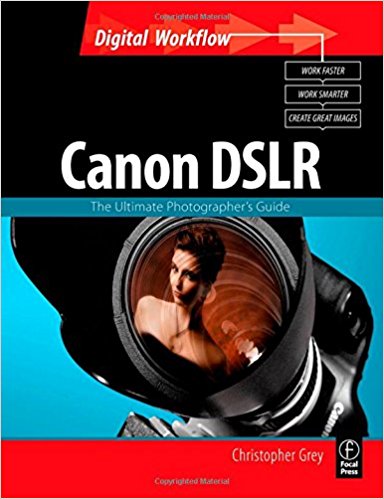Canon DSLR
writer: russell j.t. dyer; posted: aug 2009; revised: oct 2017
Review of Canon DSLR

author: Christopher Grey
edition: 1
published: 2008
publisher: Focal Press
isbn: 978-0-240-52040-7
pages: 320
Buy on Amazon
To make engineering and production simpler and especially to make using Canon cameras easier for photographers, Canon tries to keep the location of controls and settings the same between models of their EOS line of DSLR cameras. This is a nice feature for me in that I can switch between my Canon EOS 40D and 5D Mark II with ease. When traveling, I can also help fellow travelers (when asked) to set their cameras properly, even if I don’t own the same model. To these ends, Christopher Grey has written this book on Canon DSLR cameras. The book explains the various features and menus on a Canon EOS camera, pointing out differences between models. He provides photos of cameras, editing out any camera specific to depict a generic EOS camera. Since this book is part of Focal Press’ Digital Workflow series, the end of just about each chapter includes text from professional photographers explaining how they conduct their work effeciently. It’s quite a clever method and book.
The Chapters
In the first chapter, the author covers photography basics: exposure settings. This includes the range of shutter speeds for the camera line, but mostly it’s on the basics of photography and not equipment specific. The second chapter is on work-flow. This includes tips on chosing the color space to use (i.e., Adobe RGB or sRGB), taking photos in RAW image format, and some discussion on managing images files.
In the Chapter 3, Grey lists the current EOS cameras available. At the time of this review, the list is outdated. However, the book isn’t outdated — especially when you consider people use Canon cameras for many years and Canon doesn’t change the basics very much. Along those lines, Chapter 4 discusses those features that are common to all EOS cameras (e.g., auto-exposure bracketing and customizing white-balance). Chapter 5 goes through the camera modes (e.g., creative or non-automatic modes). This includes explaining shutter priority (Tv) and aperture priority (AE) modes.
In Chapter 6, Grey for some reason leaves the EOS line and discusses external light meters — but only for a couple of pages. He then reviews the various picture preset styles (e.g., landscape, neutral, faithful) for sharpness, contrast, saturation, and color tones. He provides photos of the same subjects for each so that the reader can see the differences. These examples and others throughout the book are excellent comparison shots for various settings. He also discusses color temperature settings in this chapter, as well as automatic and manual focusing with an EOS camera.
Chapter 7 is a nice chapter on the different lenses that Canon makes for the EOS system. This is useful when buying your first lenses besides the one that came with your camera. This information changes very little over the years. In Chapter 8, Grey discusses the built-in flash, as well as the settings for Canon’s external flashes, the Canon SpeedLite line. Again, he discusses their common settings.
Since the EOS cameras these days are digital cameras, Grey has dedicated Chapter 9 to using the digital image processing program provided by Canon with their cameras: the Digital Photo Professional (DPP) software. Most professionals use Adobe Photoshop or maybe Apple Aperture. However, if you don’t want to spend the extra money for one of these programs (which can be expensive), the Canon DPP utility works well. This chapter of Grey’s book has some helpful information and examples for using DPP — which is good since there aren’t that many books on the software. The final chapter is just a bunch of photographs by various photographers with comments about the photos. This chapter seems pretty unnecessary to me.
Summary
At this point, the book is outdated in many ways. In other ways, it’s still a useful book and will be so for a while longer. If you decided to buy an older model of a Canon camera, you’ll especially appreciate this book.